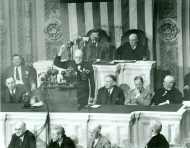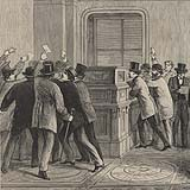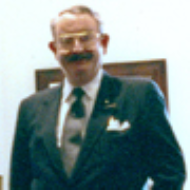Electronic Technology in
the House of Representatives
Fast Facts

Recorded and roll call votes are normally taken by electronic device, except when the Speaker orders the vote to be recorded by other methods prescribed by the Rules of the House.
More >
 Image courtesy of Library of Congress
Winston Churchill earned the distinction of being the only foreign leader to address Congress three times. In this 1943 Joint Session, network microphones surround the podium.
Image courtesy of Library of Congress
Winston Churchill earned the distinction of being the only foreign leader to address Congress three times. In this 1943 Joint Session, network microphones surround the podium.
Beginning in 1844, electronic technology fashioned an information transformation in Congress. Five technologies revolutionized the way information was disseminated from the halls of the House of Representatives to constituents in their districts: telegraph, telephone, radio, television, and computer. Samuel Morse sent the first
telegraph message from the Capitol to Baltimore, MD. Later some of the Nation's first
telephone lines were placed in Washington, D.C. The House was more cautious about embracing
radio and
television on the House Floor. Although special events were occasionally televised, the first broadcast of legislative proceedings did not take place until 1977. The computer revolution spread around the world in the 1990s and the House of Representatives was quick to join in 1993 with the first
Internet, e-mail constituent service. In the more than 150 years since Congress embraced electronic technology to communicate with the country each development has made the legislative process more accessible to Americans.

 Image courtesy of Library of Congress
Winston Churchill earned the distinction of being the only foreign leader to address Congress three times. In this 1943 Joint Session, network microphones surround the podium.
Image courtesy of Library of Congress
Winston Churchill earned the distinction of being the only foreign leader to address Congress three times. In this 1943 Joint Session, network microphones surround the podium.












